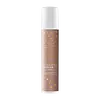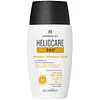What's inside
What's inside
 Key Ingredients
Key Ingredients

 Benefits
Benefits

 Concerns
Concerns

 Ingredients Side-by-side
Ingredients Side-by-side

Water
Skin ConditioningDibutyl Adipate
EmollientEthylhexyl Salicylate
UV AbsorberDiethylamino Hydroxybenzoyl Hexyl Benzoate
UV FilterGlycerin
HumectantMethylene Bis-Benzotriazolyl Tetramethylbutylphenol
UV FilterBis-Ethylhexyloxyphenol Methoxyphenyl Triazine
Skin ConditioningEthylhexyl Triazone
UV AbsorberEctoin
Skin ConditioningBetaine
HumectantOryza Sativa Starch
AbsorbentDimethicone
EmollientUndecane
EmollientPotassium Cetyl Phosphate
EmulsifyingPanthenol
Skin ConditioningCamellia Sinensis Leaf Extract
AntimicrobialTocopherol
AntioxidantTocopheryl Acetate
AntioxidantTridecane
PerfumingGlyceryl Stearate Citrate
EmollientSodium Acrylate/Sodium Acryloyldimethyl Taurate Copolymer
Emulsion StabilisingPolysorbate 80
EmulsifyingArachidyl Alcohol
EmollientDecyl Glucoside
CleansingBehenyl Alcohol
EmollientIsohexadecane
EmollientArachidyl Glucoside
EmulsifyingCaprylyl Glycol
EmollientSodium Benzoate
MaskingLactic Acid
BufferingPotassium Sorbate
PreservativeXanthan Gum
EmulsifyingSodium Hydroxide
BufferingPropylene Glycol
HumectantPhenoxyethanol
PreservativeWater, Dibutyl Adipate, Ethylhexyl Salicylate, Diethylamino Hydroxybenzoyl Hexyl Benzoate, Glycerin, Methylene Bis-Benzotriazolyl Tetramethylbutylphenol, Bis-Ethylhexyloxyphenol Methoxyphenyl Triazine, Ethylhexyl Triazone, Ectoin, Betaine, Oryza Sativa Starch, Dimethicone, Undecane, Potassium Cetyl Phosphate, Panthenol, Camellia Sinensis Leaf Extract, Tocopherol, Tocopheryl Acetate, Tridecane, Glyceryl Stearate Citrate, Sodium Acrylate/Sodium Acryloyldimethyl Taurate Copolymer, Polysorbate 80, Arachidyl Alcohol, Decyl Glucoside, Behenyl Alcohol, Isohexadecane, Arachidyl Glucoside, Caprylyl Glycol, Sodium Benzoate, Lactic Acid, Potassium Sorbate, Xanthan Gum, Sodium Hydroxide, Propylene Glycol, Phenoxyethanol
Water
Skin ConditioningDimethicone
EmollientIsododecane
EmollientC12-15 Alkyl Benzoate
AntimicrobialHydrogenated Polydecene
EmollientTitanium Dioxide
Cosmetic ColorantZinc Oxide
Cosmetic ColorantButyloctyl Salicylate
Skin ConditioningAlumina
AbrasiveStyrene/Acrylates Copolymer
Phenethyl Benzoate
EmollientPEG-9 Polydimethylsiloxyethyl Dimethicone
EmulsifyingNylon-12
Polypodium Leucotomos Leaf Extract
Skin ProtectingFerulic Acid
AntimicrobialCaffeic Acid
AntioxidantPhysalis Angulata Extract
Skin ProtectingCaprylyl Glycol
EmollientMelanin
Skin ProtectingCamellia Sinensis Extract
AntioxidantPlankton Extract
Skin Conditioning3-O-Ethyl Ascorbic Acid
Skin ConditioningIsohexadecane
EmollientHydrogen Dimethicone
Phenylpropanol
MaskingPolyhydroxystearic Acid
EmulsifyingMagnesium Sulfate
Tocopheryl Acetate
AntioxidantDimethicone/PEG-10/15 Crosspolymer
Propanediol
SolventTriethoxycaprylylsilane
Propylene Carbonate
SolventCaprylic/Capric Triglyceride
MaskingPanthenyl Triacetate
Butylene Glycol
HumectantPropylene Glycol
HumectantArginine
MaskingEthyl Linoleate
EmollientOleyl Alcohol
EmollientPentylene Glycol
Skin ConditioningOxothiazolidine
Skin ProtectingDipropylene Glycol
HumectantSodium Citrate
BufferingPalmitoyl Hydroxypropyltrimonium Amylopectin/Glycerin Crosspolymer
Skin Conditioning1,2-Hexanediol
Skin ConditioningLecithin
EmollientSodium Benzoate
MaskingTocopherol
AntioxidantHydrogenated Lecithin
EmulsifyingPhenoxyethanol
PreservativeCI 77492
Cosmetic ColorantCI 77491
Cosmetic ColorantCI 77499
Cosmetic ColorantWater, Dimethicone, Isododecane, C12-15 Alkyl Benzoate, Hydrogenated Polydecene, Titanium Dioxide, Zinc Oxide, Butyloctyl Salicylate, Alumina, Styrene/Acrylates Copolymer, Phenethyl Benzoate, PEG-9 Polydimethylsiloxyethyl Dimethicone, Nylon-12, Polypodium Leucotomos Leaf Extract, Ferulic Acid, Caffeic Acid, Physalis Angulata Extract, Caprylyl Glycol, Melanin, Camellia Sinensis Extract, Plankton Extract, 3-O-Ethyl Ascorbic Acid, Isohexadecane, Hydrogen Dimethicone, Phenylpropanol, Polyhydroxystearic Acid, Magnesium Sulfate, Tocopheryl Acetate, Dimethicone/PEG-10/15 Crosspolymer, Propanediol, Triethoxycaprylylsilane, Propylene Carbonate, Caprylic/Capric Triglyceride, Panthenyl Triacetate, Butylene Glycol, Propylene Glycol, Arginine, Ethyl Linoleate, Oleyl Alcohol, Pentylene Glycol, Oxothiazolidine, Dipropylene Glycol, Sodium Citrate, Palmitoyl Hydroxypropyltrimonium Amylopectin/Glycerin Crosspolymer, 1,2-Hexanediol, Lecithin, Sodium Benzoate, Tocopherol, Hydrogenated Lecithin, Phenoxyethanol, CI 77492, CI 77491, CI 77499
 Reviews
Reviews

Ingredients Explained
These ingredients are found in both products.
Ingredients higher up in an ingredient list are typically present in a larger amount.
Caprylyl Glycol is a humectant and emollient, meaning it attracts and preserves moisture.
It is a common ingredient in many products, especially those designed to hydrate skin. The primary benefits are retaining moisture, skin softening, and promoting a healthy skin barrier.
Though Caprylyl Glycol is an alcohol derived from fatty acids, it is not the kind that can dry out skin.
This ingredient is also used as a preservative to extend the life of products. It has slight antimicrobial properties.
Learn more about Caprylyl GlycolDimethicone is a type of synthetic silicone created from natural materials such as quartz.
What it does:
Dimethicone comes in different viscosities:
Depending on the viscosity, dimethicone has different properties.
Ingredients lists don't always show which type is used, so we recommend reaching out to the brand if you have questions about the viscosity.
This ingredient is unlikely to cause irritation because it does not get absorbed into skin. However, people with silicone allergies should be careful about using this ingredient.
Note: Dimethicone may contribute to pilling. This is because it is not oil or water soluble, so pilling may occur when layered with products. When mixed with heavy oils in a formula, the outcome is also quite greasy.
Learn more about DimethiconeIsohexadecane is added to enhance texture, emulsify, and to help cleanse. It is an isoparrafin. It is a component of petrolatum.
Due to its large size, Isohexadecane is not absorbed by the skin. Instead, it sits on top and acts as an emollient. Emollients help keep your skin soft and smooth by trapping moisture within.
Isohexadecane is often used in products designed to help oily skin. It is lightweight and non-greasy while helping to moisturize. When mixed with silicones, it gives a product a silky feel.
Learn more about IsohexadecanePhenoxyethanol is a preservative that has germicide, antimicrobial, and aromatic properties. Studies show that phenoxyethanol can prevent microbial growth. By itself, it has a scent that is similar to that of a rose.
It's often used in formulations along with Caprylyl Glycol to preserve the shelf life of products.
Propylene Glycol is an odorless, colorless liquid. As a humectant, it helps skin retain moisture. It also aids in delivering active ingredients.
Another role of this ingredient is preventing a product from melting or freezing. Propylene glycol also adds antimicrobrial properties to a product, elongating product lifespan.
This ingredient is considered an organic alcohol and commonly added into both cosmetics and foods.
Those with sensitive skin or conditions may develop a rash when using this ingredient.
Learn more about Propylene GlycolSodium Benzoate is a preservative. It's used in both cosmetic and food products to inhibit the growth of mold and bacteria. It is typically produced synthetically.
Both the US FDA and EU Health Committee have approved the use of sodium benzoate. In the US, levels of 0.1% (of the total product) are allowed.
Sodium benzoate works as a preservative by inhibiting the growth of bacteria inside of cells. It prevents the cell from fermenting a type of sugar using an enzyme called phosphofructokinase.
It is the salt of benzoic acid. Foods containing sodium benzoate include soda, salad dressings, condiments, fruit juices, wines, and snack foods.
Studies for using ascorbic acid and sodium benzoate in cosmetics are lacking, especially in skincare routines with multiple steps.
We always recommend speaking with a professional, such as a dermatologist, if you have any concerns.
Learn more about Sodium BenzoateTocopherol (also known as Vitamin E) is a common antioxidant used to help protect the skin from free-radicals and strengthen the skin barrier. It's also fat soluble - this means our skin is great at absorbing it.
Vitamin E also helps keep your natural skin lipids healthy. Your lipid skin barrier naturally consists of lipids, ceramides, and fatty acids. Vitamin E offers extra protection for your skin’s lipid barrier, keeping your skin healthy and nourished.
Another benefit is a bit of UV protection. Vitamin E helps reduce the damage caused by UVB rays. (It should not replace your sunscreen). Combining it with Vitamin C can decrease sunburned cells and hyperpigmentation after UV exposure.
You might have noticed Vitamin E + C often paired together. This is because it is great at stabilizing Vitamin C. Using the two together helps increase the effectiveness of both ingredients.
There are often claims that Vitamin E can reduce/prevent scarring, but these claims haven't been confirmed by scientific research.
Learn more about TocopherolTocopheryl Acetate is AKA Vitamin E. It is an antioxidant and protects your skin from free radicals. Free radicals damage the skin by breaking down collagen.
One study found using Tocopheryl Acetate with Vitamin C decreased the number of sunburned cells.
Tocopheryl Acetate is commonly found in both skincare and dietary supplements.
Learn more about Tocopheryl AcetateWater. It's the most common cosmetic ingredient of all. You'll usually see it at the top of ingredient lists, meaning that it makes up the largest part of the product.
So why is it so popular? Water most often acts as a solvent - this means that it helps dissolve other ingredients into the formulation.
You'll also recognize water as that liquid we all need to stay alive. If you see this, drink a glass of water. Stay hydrated!
Learn more about Water